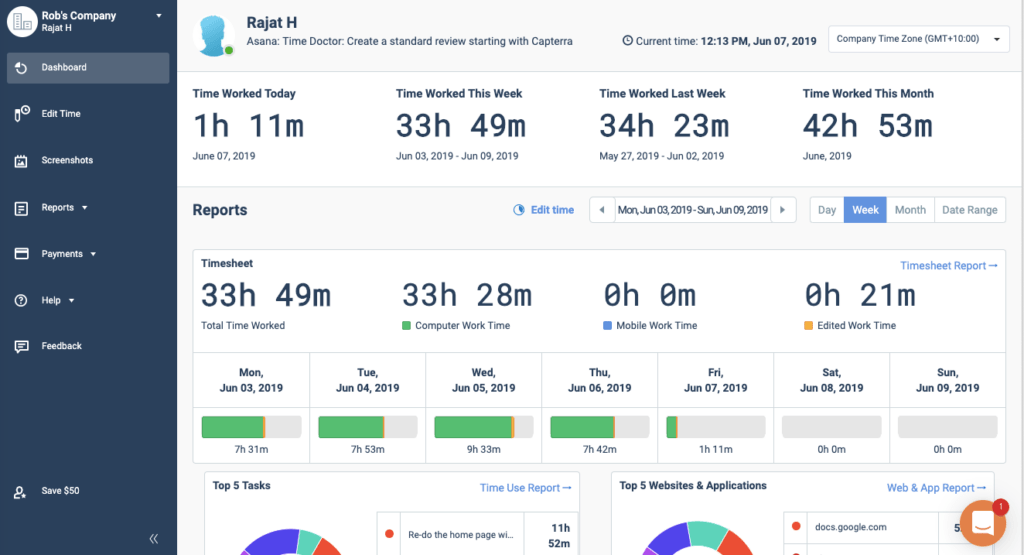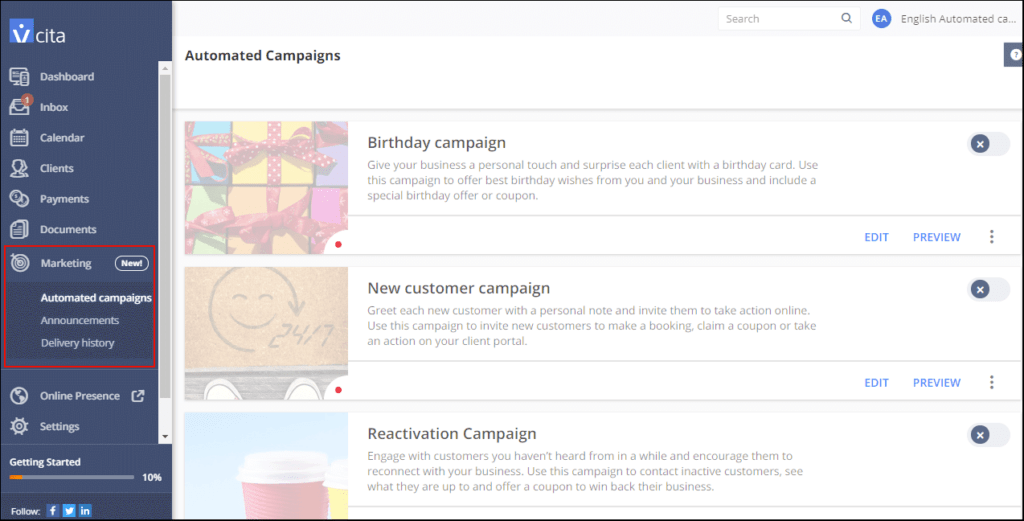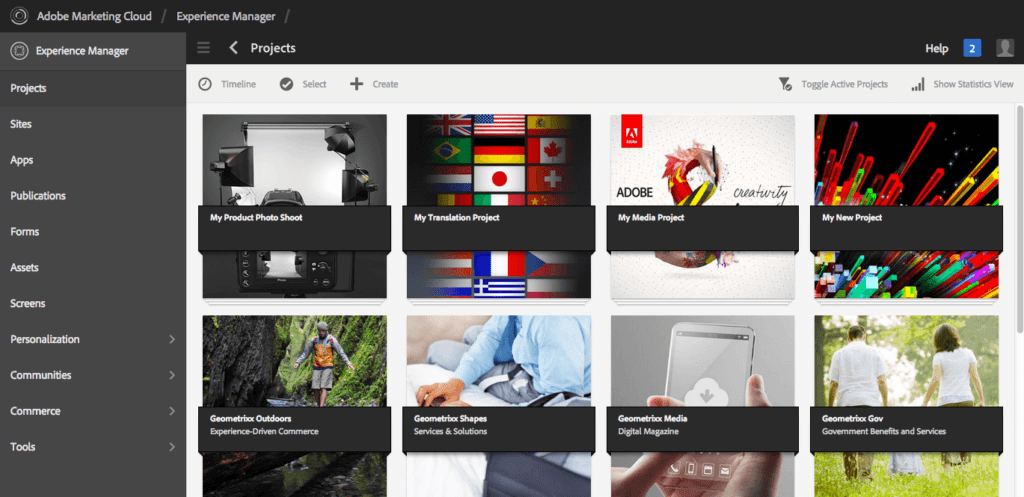As a small business owner, are administrative and managerial tasks taking up most of your productive time?
If yes, it is highly recommended that you explore small business automation options.
While administrative tasks are essential for the operational stability of your business, they are repetitive and time-consuming — which is suboptimal, to say the least.
These tasks (or responsibilities) are a roadblock to one thing you should be focusing on: propelling your business forward by working on projects that you’re great at and that inspire you. After all, that’s why you started working for yourself, isn’t it?
Fortunately, you can automate many administrative and managerial tasks with the right tools in place. Doing so will save you resources such as time, money, and labor that you can invest in business development.
Small business automation tips and tools
Here are 11 small business automation tips and tools that will assist you in spending more time on what you enjoy.
1. Measure how you spend your time
You should spend your resources as judiciously as possible, especially if you have a small team. Time tracking and management make it possible to understand and then take control of how you spend your time, your most valued resource.
Automated time tracking and management will help you in the following ways:
- Armed with insights into where you are spending more time than necessary, you can make adjustments that allow you to complete more tasks in a shorter amount of time.
- You will be relieved of stress and can make better decisions that will help you grow your business.
- As you will have more time in hand, you can spend more time doing what you want: growing your business.
Without a reliable and automated tool, it can be challenging for you to track the productive hours of each of your team members, especially if you are just starting out. Amidst all the fires you will be putting out every day, managing the time of others adds an additional layer of complexity to your workday.

Time Doctor provides an innovative solution for small businesses by helping them track time qualitatively and draw actionable insights that help teams to become more productive. Here are a few of the advantages you can look forward to with Time Doctor:
- Time tracking and employee monitoring across all devices and sites
- Distraction alerts to maintain efficiency and focus
- Productivity measuring and summary reports finding areas of improvement
- Ensure work-life balance to prevent burnout
- Integrate with your existing toolkit and get updates via email
2. Run targeted messaging campaigns for audience segments
Nurture campaigns are a method of communication where you send your prospects, leads, and customers prewritten messages to nudge them to the next step in the sales process. You can send these messages through various methods such as SMS, email, and push notifications.
The crucial thing to understand here is that you cannot adopt a one-size-fits-all approach while building nurture campaigns. Everyone in your contact list (subscribers, leads, customers, etc.) are in different stages of your sales funnel, which means that if you want your offer to resonate with them, you need to create personalized campaigns.
This involves identifying relevant parameters that help you determine where a contact is in the sales funnel and adding them to the relevant campaigns. Furthermore, you must set behavioral triggers so that the right message is sent at the right time.
Fortunately, this time-consuming but important process can easily be managed with the right CRM and email marketing tool. The issue here is that these tools can be a bit hard on the budget of budding businesses.

A small business management platform, vcita provides a simple yet effective CRM solution with an integrated email and SMS marketing tool that leverages smart targeting and automation capabilities. You can reach your audience on the platform they prefer to keep relationships strong and keep people booking service appointments.
Here are some key advantages you can look forward to with vcita:
- Get the benefits of intuitive CRM, SMS, and email marketing tools in one platform so you can tag and segment audience members according to transaction recency, past interactions, significant dates, and more
- Keep your small business workflows lean and fast
- Build targeted campaigns in minutes with readymade templates for various use cases that use pre-built automation triggers
3. Rely on chatbots to resolve customer queries
When a prospect or a lead asks you a question, it means that they are interested in what you have to offer. But you should keep in mind that they are interested at that time only. The longer you make them wait, the more likely they will take their attention elsewhere.
A survey conducted by Velocify reveals that your lead conversion rate shoots up by 391% if you reply to a prospect’s query within a minute.
As desirable as that may sound, it is impossible for small businesses to attain manual follow-up alone for the following reasons:
- Due to limited hands on deck, it is challenging to attend to each query with lightning speed
- You need to hire more employees to deliver round-the-clock support to prospects, leads, and clients
- Even if you are available to respond to a customer within a minute, finding the appropriate help resource, which has the solution to their problem, will take longer
There are tools that help automate this entire process. You can build conversational, AI-based chatbots within minutes. You can keep your business lights on 24/7 and enjoy the many advantages including the following:
- Send messages automatically to visitors based on conditional triggers
- Respond to your leads in the language and platform they are most comfortable with
- Build chatbots for various use cases within minutes through prebuilt conversational workflows
4. Personalize content for different platforms and audiences
George Ade gained popularity as a newspaper columnist in the early 20th century. He wrote stories in a conversational tone that entertained his readers, highlighting the importance of creating content that entertains and engages an audience. “Give people what they think they want,” he is said to have quipped.
This principle holds true in the world of digital marketing as well. Some 78% of customers are likely to make another purchase when they are served personalized content.
However, this can be challenging, given that your content exists in various formats, such as videos, images, GIFs, blog articles, PDFs, and so forth, which don’t lend themselves well to personalization. What’s more, your target audience consumes content on different devices and based on their demographics and psychographics, different content types might be best suited for each segment of your audience.
Businesses have to do three things to ensure their content is engaging:
- Creating content in various formats to cater to different audiences.
- Ensuring their compatibility on different devices.
- Delivering the right content in the right format at the right time.
This is difficult, to say the least, due to the availability of limited resources for small businesses.

Adobe Experience Manager (AEM) makes it easier for you to deliver great content by enabling you to:
- Create content faster with the help of a drag-and-drop environment and a library of templates
- Manage content with ease, on the cloud, where you can find the content you are looking for in the right format for your audience
- Deliver quality content to your audience regardless of their online availability with the help of AI automation at the right time
5. Post consistently on social media and measure its impact
As of 2022, Twitter, Instagram, Facebook, and LinkedIn are the 3rd, 4th, 9th, and 17th most visited websites in the world. It’s safe to assume that a huge chunk of your target audience visits one or more of those platforms frequently.
Therefore, make it a habit to stay active on social media, where your target audience is most likely to hang out, by posting engaging content and interacting with your followers while observing KPIs such as impressions and click-through rates.
This means you must create different types of content suitable for different social media platforms and keep improving your process based on how they perform.
But doing so can be difficult for three reasons:
- You must post content on different platforms and the communities/pages manually daily.
- Engaging with your audience across different platforms can get hectic.
- Measuring the performance for each post is time-consuming and frustrating as well because you have to look at the details of each post.
SocialPilot automates this process by enabling you to schedule as many as 500 posts across 50+ social media accounts through its social media content calendar. You can reply to messages and comments from your audience through this tool as well.
Its dashboards also generate actionable insights that will help you learn and optimize your social media marketing strategy.
6. Create SOPs for each process and update them regularly
Consider the following two examples:
- You have recently onboarded a sales rep who has experience with a CRM tool that you are currently using. But they don’t know how your team uses it.
- A customer success executive has joined your team. However, they are used to a conflict-resolving process that your team doesn’t follow.
Both the above examples signify that just like your audience, your business and the processes within it are unique. Even though you might use similar tools and need professionals with similar expertise, when it comes to the daily operations of your business, you are different.
This is one of the primary reasons why businesses have onboarding processes for their new employees where they give them a tour of how they work. Similarly, automated processes and workflows equip your team members to serve your clients better.
Unfortunately, creating these onboarding processes cost a lot of time and money, which is tight for budding businesses. The desired solution, in this case, would be to automate this process in the sense that the team members can learn about the processes within the organization with minimal guidance.
Document standard operating procedures (SOPs) and build robust and automated workflows. You can build automated workflows for your team and onboarding processes for your employees and clients as well.
This will help you in two distinct ways:
- You can invest the resources into your business and focus on expansion
- Your employees and outsourced service providers can easily figure out the details of your processes
7. Enable self-service through a detailed knowledge base
This is simultaneously the easiest and the most difficult method of automating the processes of your budding business. Equipping your team members and customers to help themselves to get the value they are looking for through documentation will help you in many ways:
- You can become a voice of authority in your niche with a well-written and maintained customer-facing knowledge base (KB).
- Your customers will be happier, as they don’t have to wait to get customer support or talk with a bot, leading to better reviews and higher retention rates.
- The number of customer support tickets will decrease as customers can help themselves when necessary, freeing up your resources for more judicious use.
- It will help all your team members stay aligned and perform like a well-oiled machine, regardless of location.
- Apart from improved productivity and collaboration, you can reduce the time and resources required to train employees.
Although building a knowledge base with all the information could take a lot of time initially, keep in mind that it is a one-time investment that continues to give.
Tools like Notion provide everything you need to create, publish, and manage a knowledge base for any purpose. You can collaborate with your team members while creating KB articles, discuss changes and edits, manage different versions, and import content from various sources.
You can also get actionable insights by tracking KPIs such as views, comments, and feedback.
8. Ask clients for feedback and act on them
You should get your clients’ feedback for three reasons:
- It will make them feel valued. This will bring them closer to your business and will help you build a personal relationship with them. As a result, you can increase your average order value and retention rates.
- You can improve your services. As you will understand their preferences and requirements with more clarity, personalization will become easier. You can create better content, streamline your process, and provide more options to your clients.
- It will save you resources. Rather than running surveys that take much longer to complete and cost a lot, you can gain a deeper understanding of your target audience by simply asking for feedback from your leads and clients.
Form builder tools like Jotform lets you create different types of forms within minutes from a library of templates that you can use to get all the valuable feedback you need from your clients for many use cases. You can embed them on your website, send them via email, or create pop-up forms.
More importantly, you can build visual reports and obtain actionable insights based on the submissions within minutes, which will make it possible to realize the types of value mentioned earlier. Jotform can be integrated with CMS tools, email marketing tools, and task management applications.
Jotform automates the process of collecting feedback from your clients and getting actionable insights from it, freeing up your resources that can be used for business development.
9. Identify and reward your loyal customers
In the previous section, we briefly touched on the benefits of making your customers feel valued. Rewarding loyal customers will amplify those benefits. Here is why you should identify and reward your loyal customers:
- Get ahead of the competition. Some 56% of consumers are more likely to buy from a loyalty program.
- Increase the customer lifetime value. As you will be saving them money, they are more likely to come back and stay longer.
- Maximize referral marketing. Word-of-mouth increases your brand awareness and motivates your target audience to try your product out.
To create a loyalty program, you need to answer questions such as:
- What defines a loyal customer?
- What do they consider a reward?
- How many tiers should you have?
- Should you have a points-based system?
To answer the above questions, businesses need to collect data on their users. That data needs to be analyzed to draw conclusions that will help build a loyalty program. Unsurprisingly, small businesses can’t just hit “pause” on their daily operations to do that.
Use automation to send your clients offers they are most likely to avail of based on their past interactions and preferences with your business. This will enable you to nurture client relationships and boost sales while gaining an edge over your competitors.
Furthermore, you will get actionable insights that will help you understand your customers’ motivations and requirements better.
10. Avoid potential conflicts through digital contracts
Disagreements with clients are undesirable. But they do happen, often due to circumstances beyond your control. It could be because the client had wrong expectations, or you made an error, or maybe it was due to confusion on both sides.
Whatever the reasons might be, disagreements and conflicts with clients hurt small businesses the most, because:
- They don’t have a dedicated “conflict resolution” department. So, the existing team members must pause their current work to handle the crisis.
- This will delay their existing processes and will consume a lot of resources in terms of time, money, and labor which are tight in the first place.
- If not handled properly, this will hurt their ratings which has a detrimental effect on the growth of an otherwise budding business.
Although these instances are inevitable in certain cases, you can definitely minimize them by starting off on the right foot with your client. As a business owner, you must ensure that the client is completely aware of the rules of engagement through a contract.
The challenge here is that every client is unique and has distinct requirements. Therefore, you have to create new contracts for each of your clients to match their use cases. On top of that, you have to track these contracts until they are signed.
This is boring but necessary work that will take away your resources.
Create digital contracts that help you ensure you and your clients are on the same page. They are legally enforceable through eSignatures. You can track these contracts and will be notified once they are signed.
You can also use the analytics to tweak your proposal formats over time, increasing the likelihood that a contract will be signed.
11. Implement a task management system
Usually, team members in small businesses wear multiple hats. This makes prioritization of tasks both critical and challenging. Proper prioritization helps everyone become more productive, complete goals on time, and grow the business faster.
As teams in small businesses are cross-functional, putting a robust and adaptive task management system in place will give you the following benefits:
- Improved collaboration and communication leading to efficient planning and execution within the team.
- Increased productivity on both individual and collective levels.
- Judicious use of resources such as time, money, and labor.
- Promotes a culture of transparency and accountability within the team.
As everyone prioritizes their tasks differently, a personalized solution is necessary to achieve the above benefits.
Task management software helps in the following ways:
- You can assign tasks automatically based on the availability of your team members.
- ClickUp integrates with multiple tools, so you will get all your tasks in one place.
- Collaborate with your team members through chat, whiteboards, and docs.
- Each team member can customize it as per their requirements.
Summing up
Summarized below are 11 tips and tools for small business automation that will help you spend more time doing what you prefer.
- Automatically track how you and your team spend time to set ideal targets.
- Nurture your customers and leads through segmented messaging campaigns.
- Use AI chatbots to provide assistance 24/7.
- Create, manage, and deliver personalized content to your audience using a CMS with AI-driven insights.
- Post consistently on social media to continue engaging with your audience using social media automation tools.
- Simplify client and employee onboarding with SOPs using client management software.
- Equip your clients and employees to help themselves with a KB using tools like Notion.
- Automate the process and put insights from timely collected feedback from clients into action.
- Thank your loyal customers by creating special offers for them using automation.
- Ensure you and your clients are on the same page through digital contracts.
- Put an automated task management system in place.

Lucy Manole is a creative content writer and strategist at Marketing Digest. She specializes in writing about digital marketing, technology, entrepreneurship, and education. When she is not writing or editing, she spends time reading books, cooking and traveling.


